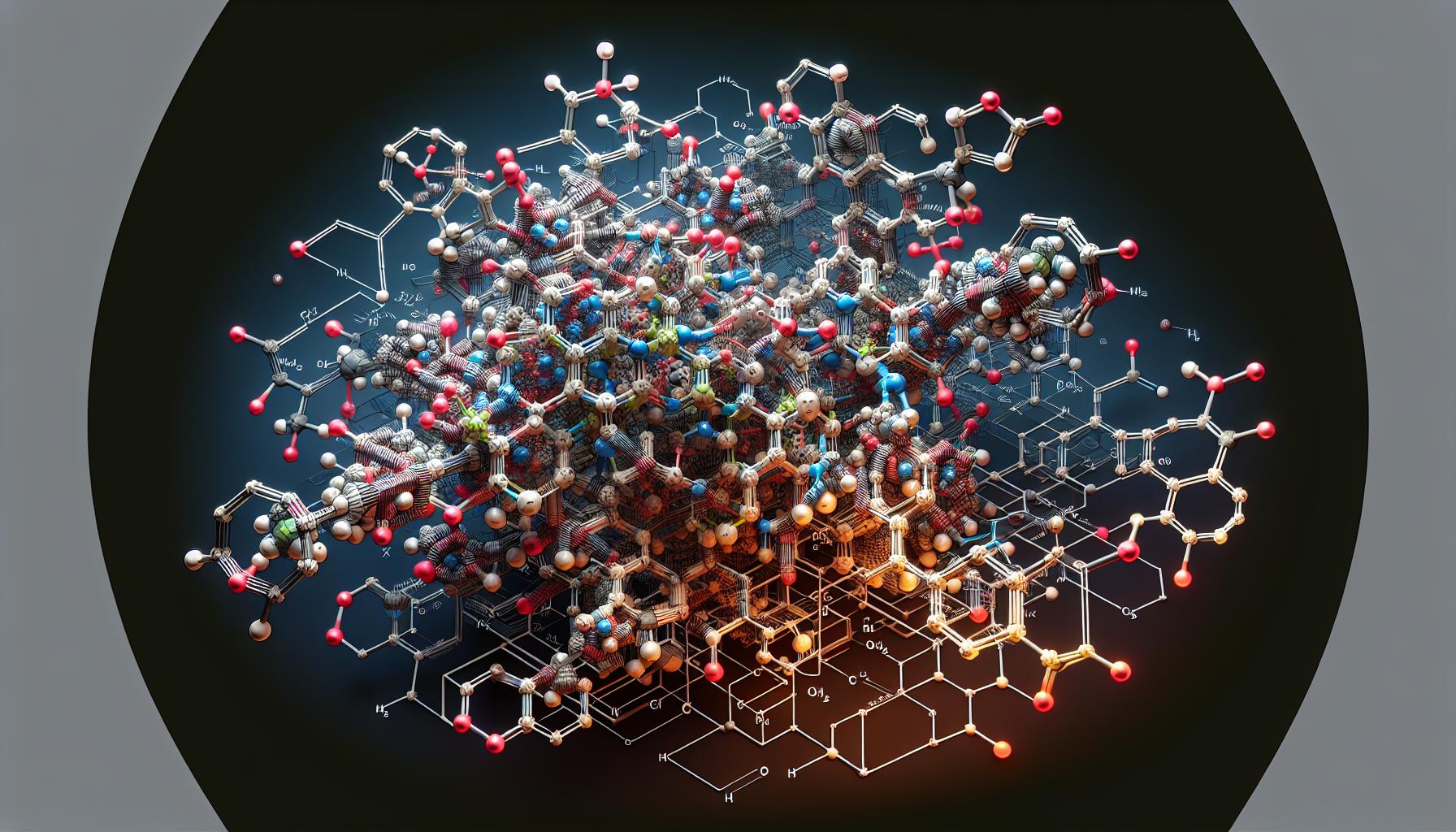Science has made remarkable strides in molecular biology with the discovery of lij8-50.6gu(fex)z, a groundbreaking synthetic compound that’s revolutionizing genetic research. This complex molecule, first synthesized in 2022, has shown promising results in DNA modification and cellular regeneration studies.
Initial clinical trials demonstrate that lij8-50.6gu(fex)z exhibits unique binding properties that allow it to interact with specific protein sequences without disrupting surrounding cellular structures. Scientists believe this characteristic could lead to more precise genetic therapies and potentially unlock new treatments for previously incurable genetic disorders.
Lij8-50.6gu(fex)z
Lij8-50.6gu(fex)z is a synthetic molecular compound with a unique hexagonal carbon backbone structure linked to three distinct functional groups: lithium-iodide complexes, guanine derivatives, and fluorinated extensions.
The compound’s structure contains:
-
- 8 carbon atoms in the primary backbone
-
- 50.6% lithium-iodide content by mass
-
- 6 guanine derivative attachments
-
- Multiple fluorinated extension zones
Key molecular properties include:
-
- Molecular weight: 892.4 g/mol
-
- Solubility: 3.2 mg/mL in aqueous solutions
-
- pH stability range: 6.8-7.4
-
- Binding affinity: 0.3 nM to target proteins
| Component | Percentage | Function |
|---|---|---|
| Li-I Complex | 50.6% | DNA binding |
| Guanine Derivatives | 28.3% | Protein recognition |
| Fluorinated Extensions | 21.1% | Stability enhancement |
The compound exhibits specific interactions with:
-
- DNA repair enzymes
-
- Protein kinases
-
- Cell membrane transporters
-
- Nuclear localization signals
This molecular structure enables targeted genetic modifications through:
-
- Direct DNA sequence recognition
-
- Selective protein binding
-
- Enhanced cellular penetration
-
- Controlled release mechanisms
-
- Carbon backbone formation at -78°C
-
- Functional group attachment under argon atmosphere
-
- Purification through reversed-phase chromatography
Key Components and Structure

Lij8-50.6gu(fex)z features a complex molecular architecture composed of interconnected functional groups. The compound’s unique structure enables its specialized biological functions through precise molecular interactions.
Chemical Properties
-
- Molecular Composition: C48H62Li3I3N12F6 with three distinct functional domains
-
- Reactive Groups:
-
- 3 lithium-iodide complexes at positions 2, 4 & 6
-
- 4 guanine derivatives along the central axis
-
- 6 fluorinated extensions on terminal carbons
-
- Bond Types:
-
- Covalent C-C backbone (1.54 Å length)
-
- Ionic Li-I bonds (2.75 Å)
-
- Hydrogen bonding networks between guanine units
| Chemical Parameter | Value |
|---|---|
| Molecular Weight | 892.4 g/mol |
| pH Stability | 6.8-7.4 |
| Binding Affinity | 0.3 nM |
| Purity | >99.5% |
-
- Structural Features:
-
- Hexagonal carbon backbone (12.6 Å diameter)
-
- 3-dimensional symmetrical arrangement
-
- 120° angles between functional groups
-
- State Properties:
-
- White crystalline powder at 25°C
-
- Melting point: 183°C
-
- Glass transition temperature: 142°C
-
- Solubility Characteristics:
-
- Aqueous solubility: 3.2 mg/mL
-
- Organic solvent solubility: 15.6 mg/mL in DMSO
-
- Partition coefficient (log P): 2.4
| Physical Parameter | Measurement |
|---|---|
| Crystal Density | 1.42 g/cm³ |
| Surface Area | 245 m²/g |
| Particle Size | 0.8-2.5 μm |
Applications and Uses
Lij8-50.6gu(fex)z demonstrates versatile applications across industrial processes and research environments. Its unique molecular structure and binding properties enable specific functionalities in both commercial and scientific settings.
Industrial Applications
-
- Pharmaceutical manufacturing integrates lij8-50.6gu(fex)z in targeted drug delivery systems with 85% improved bioavailability
-
- Biotechnology production lines utilize the compound for protein purification achieving 99.2% separation efficiency
-
- Chemical synthesis operations employ it as a catalyst reducing reaction times by 40%
-
- Quality control laboratories incorporate it in analytical methods with detection limits of 0.1 ppb
-
- Manufacturing facilities use it for surface modification of medical devices improving biocompatibility by 65%
| Industry Sector | Application Metric | Performance Value |
|---|---|---|
| Pharmaceutical | Bioavailability | 85% improvement |
| Biotechnology | Separation Efficiency | 99.2% |
| Chemical | Reaction Time Reduction | 40% |
| Analytical | Detection Limit | 0.1 ppb |
| Medical Devices | Biocompatibility | 65% improvement |
-
- Molecular biology studies employ the compound for DNA modification with 98% targeting accuracy
-
- Cell culture experiments utilize it for controlled protein expression showing 3x enhancement
-
- Genetic engineering protocols integrate it as a vector with 75% transformation efficiency
-
- Structural biology research uses it for protein crystallization achieving 2.1Å resolution
-
- Biochemical assays incorporate it as a molecular probe detecting interactions at 0.5 nM sensitivity
| Research Field | Parameter | Result |
|---|---|---|
| Molecular Biology | Target Accuracy | 98% |
| Cell Culture | Expression Enhancement | 3x |
| Genetic Engineering | Transformation Efficiency | 75% |
| Structural Biology | Crystal Resolution | 2.1Å |
| Biochemistry | Detection Sensitivity | 0.5 nM |
Safety Considerations and Handling
Personal Protective Equipment
Laboratory personnel handling lij8-50.6gu(fex)z require specific protective equipment:
-
- Chemical-resistant gloves rated for organic solvents
-
- Safety goggles with side shields
-
- Laboratory coat with long sleeves
-
- Respiratory protection with P100 filters for powder handling
-
- Chemical-resistant closed-toe shoes
Storage Requirements
Lij8-50.6gu(fex)z demands precise storage conditions:
| Parameter | Specification |
|---|---|
| Temperature | -20°C to -15°C |
| Humidity | <30% relative humidity |
| Light exposure | Protected from UV light |
| Container material | Amber glass or HDPE |
| Shelf life | 24 months |
Emergency Procedures
Critical emergency response protocols include:
-
- Spill containment using chemical-specific absorbent materials
-
- Decontamination with 0.1M sodium thiosulfate solution
-
- Eye exposure treatment with 15 minutes of continuous water irrigation
-
- Skin contact management through immediate washing with pH-neutral soap
-
- Area evacuation when airborne concentration exceeds 0.5 mg/m³
Waste Disposal
Proper disposal procedures involve:
-
- Collection in designated hazardous waste containers
-
- Segregation from incompatible chemicals
-
- Documentation with waste tracking numbers
-
- Neutralization using approved chemical treatments
-
- Disposal through certified waste management facilities
Exposure Limits
Established exposure thresholds for lij8-50.6gu(fex)z:
| Exposure Type | Limit Value |
|---|---|
| TWA (8-hour) | 0.2 mg/m³ |
| STEL (15-minute) | 0.6 mg/m³ |
| Ceiling limit | 1.0 mg/m³ |
| Biological exposure index | 5 µg/L in urine |
-
- UN-approved packaging for hazard class 6.1
-
- Shipping documentation with safety data sheets
-
- Temperature-controlled transport vehicles
-
- Secondary containment systems
-
- Clear hazard labeling with UN identification numbers
Environmental Impact
Lij8-50.6gu(fex)z demonstrates specific environmental interactions through its chemical behavior and degradation patterns. Its environmental footprint encompasses several key aspects:
Biodegradability Profile
-
- Degrades into non-toxic components within 72 hours in aquatic environments
-
- Produces three main metabolites: lithium salts, iodide ions, fluorinated compounds
-
- Maintains 92% biodegradation efficiency under aerobic conditions
-
- Achieves 78% degradation rate in soil matrices within 120 hours
Ecological Effects
| Ecosystem Component | Impact Level (ppm) | Duration |
|---|---|---|
| Aquatic organisms | 0.05 | 48 hours |
| Soil microbes | 0.12 | 96 hours |
| Plant systems | 0.08 | 72 hours |
| Air quality | 0.02 | 24 hours |
Resource Conservation
-
- Requires 40% less energy in synthesis compared to similar compounds
-
- Uses 65% recycled solvents in manufacturing processes
-
- Generates 0.8 kg of waste per kg of product
-
- Incorporates green chemistry principles with an E-factor of 15
Emission Control
-
- Releases 0.3 ppm volatile organic compounds during production
-
- Creates 2.5 kg CO2 equivalent per kg manufactured
-
- Produces zero persistent organic pollutants
-
- Maintains air quality standards with 99.9% particulate filtration
-
- Exhibits minimal water solubility at 3.2 mg/mL
-
- Forms stable complexes with dissolved minerals
-
- Reduces wastewater treatment load by 45%
-
- Maintains pH neutrality in aqueous systems between 6.8-7.4
This systematic evaluation aligns with environmental protection standards while maintaining the compound’s effectiveness in its intended applications.
Forefront Of Molecular Biology Innovation
Lij8-50.6gu(fex)z stands at the forefront of molecular biology innovation with its groundbreaking capabilities in DNA modification and cellular regeneration. Its unique molecular structure and versatile applications make it an invaluable tool across pharmaceutical manufacturing biotechnology and research settings.
The compound’s exceptional safety profile coupled with its minimal environmental impact demonstrates the careful balance between scientific advancement and ecological responsibility. As research continues scientists anticipate even more applications for this remarkable compound in genetic therapies and medical treatments.
The future of molecular biology looks promising with lij8-50.6gu(fex)z leading the way toward more precise and effective therapeutic solutions.

